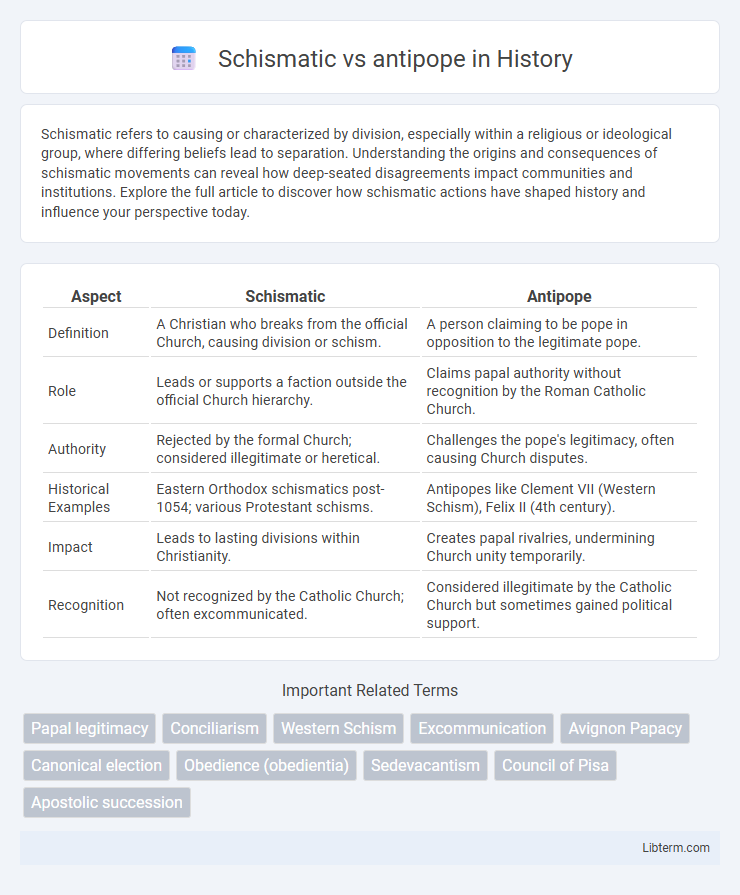Schismatic refers to causing or characterized by division, especially within a religious or ideological group, where differing beliefs lead to separation. Understanding the origins and consequences of schismatic movements can reveal how deep-seated disagreements impact communities and institutions. Explore the full article to discover how schismatic actions have shaped history and influence your perspective today.
Table of Comparison
| Aspect | Schismatic | Antipope |
|---|---|---|
| Definition | A Christian who breaks from the official Church, causing division or schism. | A person claiming to be pope in opposition to the legitimate pope. |
| Role | Leads or supports a faction outside the official Church hierarchy. | Claims papal authority without recognition by the Roman Catholic Church. |
| Authority | Rejected by the formal Church; considered illegitimate or heretical. | Challenges the pope's legitimacy, often causing Church disputes. |
| Historical Examples | Eastern Orthodox schismatics post-1054; various Protestant schisms. | Antipopes like Clement VII (Western Schism), Felix II (4th century). |
| Impact | Leads to lasting divisions within Christianity. | Creates papal rivalries, undermining Church unity temporarily. |
| Recognition | Not recognized by the Catholic Church; often excommunicated. | Considered illegitimate by the Catholic Church but sometimes gained political support. |
Understanding Schismatics in Church History
Schismatics in church history represent individuals or groups who caused a formal division within the Christian community by rejecting the authority of the established church leadership, often leading to enduring doctrinal or organizational splits. Unlike antipopes, who claim the papal office in opposition to the legitimately recognized pope, schismatics break away without asserting a competing papal claim but instead reject jurisdictional or doctrinal unity. Key historical schisms, such as the Great Schism of 1054, highlight the significant impact of schismatics on shaping diverse Christian traditions and ecclesiastical structures.
Defining the Term “Antipope”
An antipope is a person who makes a contested claim to be the legitimate pope, opposing the pope recognized by the Roman Catholic Church. This designation arises during schismatic periods, where divisions within the church lead to rival papal claimants. Antipopes often gain support from factions or political entities challenging the established papal authority.
Key Differences Between Schismatics and Antipopes
Schismatics are individuals or groups who cause or support a formal division within the Church, rejecting the authority of the legitimate pope without claiming papal authority themselves. Antipopes, in contrast, are specific claimants to the papacy who assert themselves as pope in opposition to the legitimately recognized pope. The key difference lies in their roles: schismatics disrupt unity by dissent, while antipopes directly contest the papal office, often leading to contested leadership and confusion within the Church.
Historical Origins of Schisms
The historical origins of schisms trace back to disputes over papal succession and doctrinal authority, often leading to competing claims to the papacy known as antipopes. Schisms typically arise from broader ecclesiastical conflicts, reflecting deep divisions within the Church's hierarchy and laity, while antipopes embody the direct challenge of a rival claimant to the legitimate pope. Key examples include the Western Schism (1378-1417), where multiple antipopes emerged simultaneously, significantly fragmenting Christendom and highlighting the interplay between political power and religious legitimacy.
Notable Examples of Schismatics
Notable examples of schismatics include figures like the Western Schism claimants Clement VII and Benedict XIII, who led rival papacies in the 14th century, fracturing the Catholic Church's unity. Another prominent schismatic was Martin Luther, whose 16th-century Reformation movement challenged papal authority and resulted in significant ecclesiastical division. These schismatics differ from antipopes, who typically claim the papal office illegitimately, whereas schismatics challenge broader church structures or doctrines leading to sustained divisions.
Famous Antipopes Throughout the Centuries
Famous antipopes, such as Clement VII during the Western Schism (1378-1417), significantly challenged the unity of the Catholic Church by claiming the papal throne simultaneously with legitimate popes. Benedict XIII and Alexander V also stand out as notable antipopes whose claims intensified ecclesiastical divisions and prolonged the schismatic periods. These figures exemplify the complex historical conflicts over papal legitimacy that shaped church politics and theology across centuries.
Causes Behind Ecclesiastical Schisms
Ecclesiastical schisms often arise from theological disputes, political power struggles, or challenges to papal authority, leading to the emergence of schismatics who reject the established Church hierarchy. Antipopes typically appear during these periods of conflict as rival claimants to the papacy, fueled by factions seeking to assert alternative leadership. These divisions are rooted in complex interactions between doctrinal disagreements and competing loyalties within the Church's institutional framework.
Church Responses to Schismatics and Antipopes
The Church responded to schismatics by reaffirming doctrinal unity and enforcing canonical penalties to preserve ecclesiastical authority and prevent fragmentation. In dealing with antipopes, the Church convened councils such as the Council of Constance (1414-1418) to resolve papal disputes, restore legitimate pontifical succession, and enforce obedience among the faithful. These measures reinforced centralized Church governance and aimed to maintain theological coherence and institutional stability during periods of internal conflict.
Lasting Impact on Catholic Doctrine and Unity
Schismatic groups challenge the unity of the Catholic Church by rejecting the authority of the Pope, resulting in doctrinal fragmentation and weakened ecclesiastical cohesion. Antipopes, as rival claimants to the papal throne, create temporary crises of legitimacy that prompt councils and reforms to reaffirm Catholic doctrine and papal primacy. The lasting impact of schisms and antipopes underscores the Church's efforts to preserve doctrinal unity and centralize authority within the papacy to maintain global ecclesial stability.
Lessons Learned from Schisms and Antipapacies
Schisms and antipapacies reveal key lessons on the importance of ecclesiastical unity and authority legitimacy in the Catholic Church, highlighting how divided allegiances can weaken institutional cohesion. Historical conflicts such as the Western Schism demonstrate the critical need for clear election protocols and centralized leadership to prevent rival claims to the papacy. These episodes underscore the ongoing challenge of balancing doctrinal integrity with political influences to maintain the Church's spiritual and organizational stability.
Schismatic Infographic

 libterm.com
libterm.com